Aston Martin Vanquish Zagato concept unveiled
 The Aston Martin Vanquish Zagato concept has been revealed at the Concorso d’Eleganza Villa d’Este at Lake Como in Italy. This the fifth collaboration between the legendary British car maker and the Italian design house. The concept has been developed and engineered at Aston Martin’s headquarters in Gaydon.
The Aston Martin Vanquish Zagato concept has been revealed at the Concorso d’Eleganza Villa d’Este at Lake Como in Italy. This the fifth collaboration between the legendary British car maker and the Italian design house. The concept has been developed and engineered at Aston Martin’s headquarters in Gaydon.

 The Aston Martin Vanquish Zagato concept features bodywork in carbon fibre along with large one piece panels. There are round tail light reflectors which give the classic look of Zagato design. They get the same ‘bladed’ LED technology as the Aston Martin Vulcan track-only supercar.
The Aston Martin Vanquish Zagato concept features bodywork in carbon fibre along with large one piece panels. There are round tail light reflectors which give the classic look of Zagato design. They get the same ‘bladed’ LED technology as the Aston Martin Vulcan track-only supercar.
The rear view mirrors are inspired from the One-77 and the aerodynamic rear profile is similar to that of the DB11 and comes with a retractable spoiler. There is a quad exhaust system and carbon fibre sills that run along the lower body of the car. A sharp crease on the rear wheel arch transforms into the rear fender and meets the cascading roofline. The roof features the iconic ‘double bubble’ design that has been a Zagato design trademark since 1950.
On the interior, the Aston Martin Vanquish Zagato concept gets a mix of carbon fibre and anodized bronze along with aniline leather. These give the dashboard, vents and dials a very rich and premium feel. The unique ‘Z’ pattern stitch is used on the seats and doors, while the Zagato ‘Z’ is embossed on the headrests and stitched into the centre console.

 Aston Martin Executive Vice President and Chief Creative Officer, Marek Reichman said ‘Over the years, we have developed and refined our own design language and we have always gone that little bit further with our special series cars like CC-100, One-77 and Aston Martin Vulcan. The Vanquish Zagato Concept shows how our two companies can come together and push the definition of Aston Martin design.’
Aston Martin Executive Vice President and Chief Creative Officer, Marek Reichman said ‘Over the years, we have developed and refined our own design language and we have always gone that little bit further with our special series cars like CC-100, One-77 and Aston Martin Vulcan. The Vanquish Zagato Concept shows how our two companies can come together and push the definition of Aston Martin design.’
‘We pride ourselves on our strong partnership and the creation of the Vanquish Zagato Concept was a true shared experience,’ says Zagato’s CEO, Andrea Zagato, ‘it represents the essence of an important design relationship that dates back over fifty years.’





